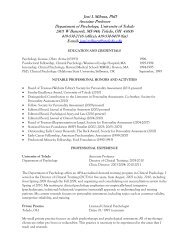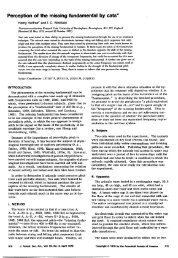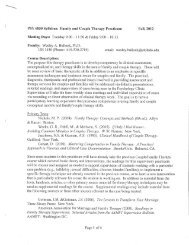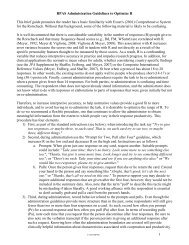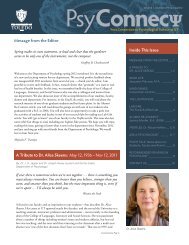The Rorschach Rating Scale: Item Adequacy, Scale ... - Psychology
The Rorschach Rating Scale: Item Adequacy, Scale ... - Psychology
The Rorschach Rating Scale: Item Adequacy, Scale ... - Psychology
- No tags were found...
Create successful ePaper yourself
Turn your PDF publications into a flip-book with our unique Google optimized e-Paper software.
TABLE 5Prediction of RRS <strong>Scale</strong>s From Forced Entry of All B5M <strong>Scale</strong>sCriterion <strong>Scale</strong> R 2 RRRS Factor-Derived <strong>Scale</strong>s1. Narcissism, Aggression, and Dominance .53 .732. Perceptual Distortions and Thought Disorder .30 .553. Passive Dependence, Vulnerability, and Inferiority .34 .584. Emotional Health and Coping Effectiveness .41 .645. Social and Emotional Engagement .37 .616. Intellectual Defenses and Obsessive Character .11 .33M .34 .57RRS Factor Scores1. Narcissism, Aggression, and Dominance .41 .642. Perceptual Distortions and Thought Disorder .14 .373. Passive Dependence, Vulnerability, and Inferiority .36 .604. Emotional Health and Coping Effectiveness .25 .505. Social and Emotional Engagement .49 .706. Intellectual Defenses and Obsessive Character .11 .33M .29 .52RRS Conceptually Derived <strong>Scale</strong>sRRS Neuroticism .58 .76RRS Extraversion–Sociability .58 .76RRS Openness–Emotional Sensitivity .46 .68RRS Agreeableness Versus Hostility .65 .81RRS Conscientiousness–Thoroughness .43 .65Defensive Avoidance of Negative Affect .12 .35Perceptual Distortions .41 .64Diffuse Psychological Boundaries .50 .71Polarized Self- and Object-Representations .50 .71Narcissism .57 .76Effective Coping .48 .69Global, Vague, and Impressionistic Thinking .39 .62Formal Thought Disorder .26 .51Gaps in Memory or Experience .19 .43Emotional Spontaneity .22 .47Dependent Needs for Others .31 .55Projection and Projective Identification .51 .71Sexual Preoccupations .12 .35Attention to Small/Unusual Details .30 .54M .40 .62Note. N = 224. RRS = <strong>Rorschach</strong> <strong>Rating</strong> <strong>Scale</strong>; B5M = Big Five model. <strong>The</strong> final R and R 2 valueswere quite similar when B5M factor scores were used rather than B5M scales derived from the sum ofraw scores. Consequently, results for the B5M factor scores were not presented.222Copyright © 2000 All Rights Reserved



